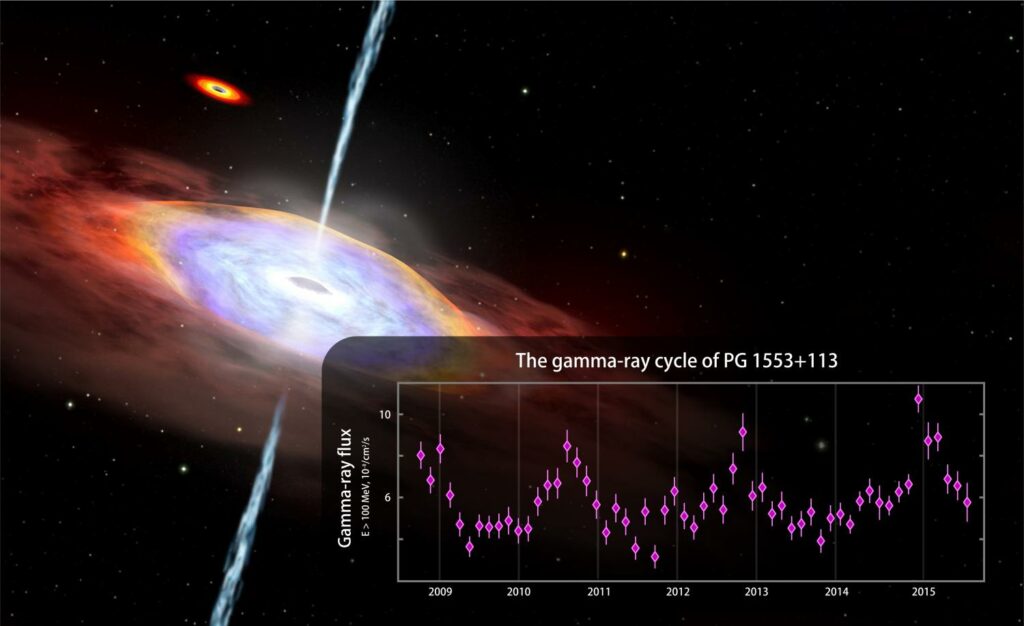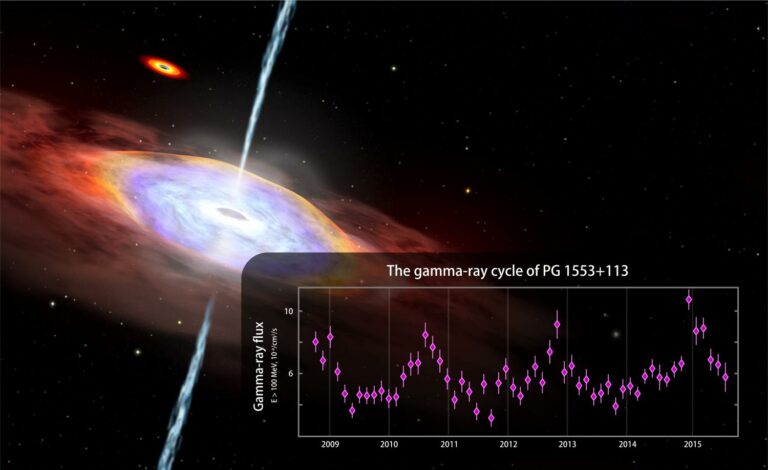Fermi Mission Uncovers Indications of Gamma-Ray Cycle in an Active Galaxy
Astronomers have made a significant discovery using data from NASA’s Fermi Gamma-ray Space Telescope. They have observed potential periodic changes in the brightness of an “active” galaxy, which is powered by a massive black hole. If confirmed, this finding would be the first instance of long-term cyclic gamma-ray emission ever detected from any galaxy. It could offer valuable insights into the physical processes occurring near black holes.
Stefano Ciprini, who leads the Fermi team at the Italian Space Agency’s Science Data Center (ASDC) in Rome, explained that they analyzed several years’ worth of data from Fermi’s Large Area Telescope (LAT). They found indications of a roughly two-year-long variation in gamma rays emitted by a galaxy known as PG 1553+113. However, Ciprini emphasized that this signal is subtle and has only been observed over less than four cycles. Therefore, further observations are necessary to confirm this intriguing discovery.
Most large galaxies, including our own Milky Way, harbor supermassive black holes that weigh millions of times the mass of the sun. In approximately 1 percent of these galaxies, the supermassive black hole emits billions of times more energy than the sun. This emission can vary unpredictably over timescales ranging from minutes to years, leading astronomers to classify these galaxies as active galaxies.

Blazars, a type of active galaxy, make up more than half of the gamma-ray sources detected by Fermi’s LAT. PG 1553+113 is one such blazar. As matter falls towards the supermassive black hole at the center of the galaxy, some subatomic particles escape at nearly the speed of light through two jets that point in opposite directions. The exceptional brightness of a blazar stems from one of these particle jets being almost directly aligned with our line of sight.
Sara Cutini, an astrophysicist at ASDC, explained that by observing the variations in brightness of the jet, scientists can gain insight into its structure and the surrounding environment near the black hole. In order to explore the possibility of regular gamma-ray changes, the researchers analyzed a decade’s worth of multiwavelength data. This included optical observations from Tuorla Observatory in Finland, Lick Observatory in California, and the Catalina Sky Survey near Tucson, Arizona, as well as optical and X-ray data from NASA’s Swift spacecraft. Additionally, they studied observations from the Owens Valley Radio Observatory in California, which has been monitoring PG 1553+113 every few weeks since 2008 as part of a blazar monitoring program for the Fermi mission.
Stefan Larsson, a researcher at the Royal Institute of Technology in Stockholm and a collaborator with the ASDC team, noted that the cyclic variations observed in visible light and radio waves are similar to those seen in high-energy gamma-rays from Fermi. This consistency across a wide range of wavelengths suggests that the periodicity is real and not just a fluctuation in the gamma-ray data.
The findings of Ciprini, Cutini, Larsson, and their colleagues were published in the Nov. 10 edition of The Astrophysical Journal Letters. If the gamma-ray cycle of PG 1553+113 is indeed real, they predict that it will peak again in 2017 and 2019, which falls within Fermi’s expected operational lifetime.
The scientists have identified several possible scenarios that could explain the periodic emission, including mechanisms that could cause a years-long wobble in the jet of high-energy particles emitted by the black hole. One particularly intriguing scenario involves the presence of a second supermassive black hole in close orbit with the one producing the observed jet. The gravitational pull of this neighboring black hole would periodically tilt the inner part of its companion’s accretion disk.
This article is republished from PhysORG under a Creative Commons license. Read the original article.
Do not forget to share your opinion with us to provide you with the best posts !




0 Comments